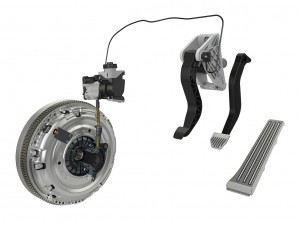Schaeffler is providing intelligent, automatic solutions for previously purely mechanical or hydraulic clutch systems. Depending on the development stage, the system known to experts as the “E-Clutch” either operates the clutch only in specific driving situations or completely automates all clutch operations. This allows fuel-saving driving strategies, from “sailing” to electrically supported driving, to be integrated into vehicles with manual transmissions. “The E-Clutch from Schaeffler paves the way for hybridization of manual transmissions, thereby opening up new markets and market segments,” says Uwe Wagner, Vice President Automotive R&D at Schaeffler. Up until now, this has been possible only in combination with automatic transmissions. This is a decisive step. This type of transmission is far and away the most commonly used in many growing economies as well as in the lower and middle market segments in the European market. Today, approximately 50 per cent of all vehicles has a manual transmission even as global production continues to increase.
One Idea, Three Concepts
Schaeffler has developed three stepped concepts of the E-Clutch for manual transmissions depending on the level of automation. In the MTplus variant, the basic principle of transmitting forces hydraulically is maintained but with the addition of an actuator directly in the pressure line. The advantage: In this arrangement, the demands on actuation times and number of actuations are lower, which means lower demands on performance. “By using this method, Schaeffler has managed to keep the on-costs of the MTplus to a minimum compared to a classic clutch operating system,” explains Markus Kneißler, E-Clutch System Development Manager for the Schaeffler LuK brand.
Even partial automation makes a significant contribution to reducing fuel consumption when “sailing”: During continuous driving, the engine is disconnected from the transmission and is either completely switched off or idles. The MTplus system disconnects the transmission. The driver provides the signal for this indirectly by taking his foot off the gas pedal. Tests using the up-and-coming consumption measurement cycle according to WLTP and realistic customer cycles have recorded reductions in fuel consumption from two per cent (engine goes to idle) to six percent (engine switches off). Using a 1.2 liter gasoline engine demonstration vehicle, Schaeffler has shown that it is possible to achieve savings of up to eight percent in urban driving conditions. The function of “sailing” not only helps in the future consumption cycle, but can also be claimed today as an “eco-innovation” for the approval of reduced CO2 emissions.
Intelligent Clutch Pedal
In the clutch-by-wire development stage, the mechanical or hydraulic connection between the pedal and the clutch release system is replaced completely. The opposing force on the pedal from the clutch release system, which no longer exists, is now generated by a new pedal force adjuster developed by Schaeffler. This contains an additional sensor which sends a signal on the pedal position to a clutch actuator. The driver is not therefore immediately aware of the automatic engagement but continues to drive as normal with a manual transmission. A recently developed, intelligent actuator undertakes the actual opening and closing of the clutch in all driving situations. It consists of a basic actuator which includes all the electronics, the e-motor, and a spindle drive. The connection to the clutch actuation is either mechanical or hydraulic depending on the application. The modular design means that it is universally applicable and this also reduces the development and overall system costs. This is important in order to be able to maintain the economic advantages of manual transmissions compared to automatic transmissions.
Clutch-by-wire is much more powerful than MTplus: The functionality of this clutch release system means it can accommodate situations with very high dynamic requirements, such as rapid shifting and emergency braking. The option of electrically tuning the transfer from pedal travel to clutch travel is regarded as particularly convenient. This makes it possible to have gear-related adaptation or a sport mode option, previously reserved for automatic transmissions only. This technology’s performance can be clearly seen in the “Gasoline Technology Car” (GTC) developed by Schaeffler in conjunction with Ford and Continental, where reductions in consumption and CO2 emissions of 17 percent have been achieved with the automatic clutch making a significant contribution to this.
Electronic Clutch Management (ECM) is technically based on the same system, but without a clutch pedal. A sensor provides the signal for disengagement when the driver changes gear. Engagement follows automatically once the gear is selected. The high degree of automation in the ECM provides a good basis for integrating an electric motor into the drive train. By using a suitable battery in a 48 V on-board electric system, this system is used to drive the vehicle in all instances when the engine is running uneconomically, for example, when parking, in stop/start traffic or at low-speed urban driving conditions. “ECM provides a technically elegant and economical step up to mild hybridization which could not be achieved with an automatic transmission,” explains Kneißler. The E-Clutch system from Schaeffler not only opens up new prospects for manual transmissions, but this configuration also provides a way into new markets and market segments for hybridized transmissions.












Leave a Reply